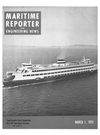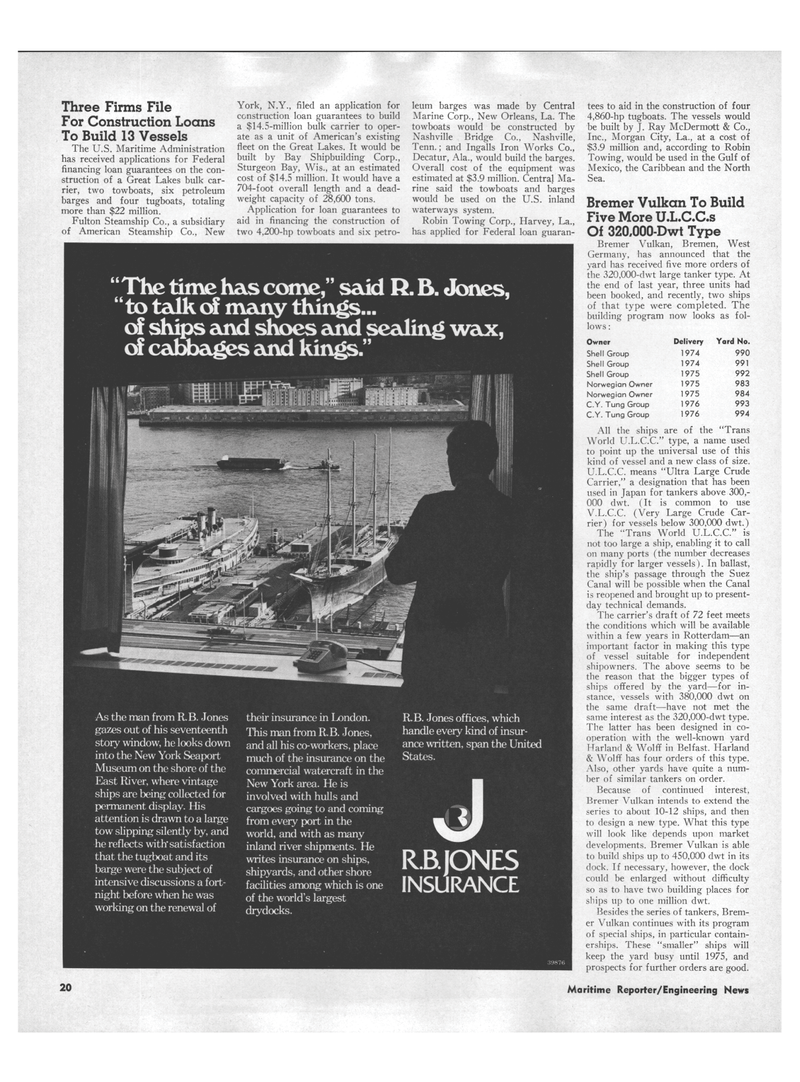
Page 16: of Maritime Reporter Magazine (March 1973)
Read this page in Pdf, Flash or Html5 edition of March 1973 Maritime Reporter Magazine
York, N.Y., filed an application for construction loan guarantees to build a $14.5-million bulk carrier to oper- ate as a unit of American's existing fleet on the Great Lakes. It would be built by Bay Shipbuilding Corp.,
Sturgeon Bay, Wis., at an estimated cost of $14.5 million. It would have a 704-foot overall length and a dead- weight capacity of 28,600 tons.
Application for loan guarantees to aid in financing the construction of two 4,200-hp towboats and six petro-
Three Firms File
For Construction Loans
To Build 13 Vessels
The U.S. Maritime Administration has received applications for Federal financing loan guarantees on the con- struction of a Great Lakes bulk car- rier, two towboats, six petroleum barges and four tugboats, totaling more than $22 million.
Fulton Steamship Co., a subsidiary of American Steamship Co., New "The time has come," said R. B. Jones, "to talk of many things... of ships and shoes and sealing wax, of cabbages and kings " Owner Shell Group
Shell Group
Shell Group
Norwegian Owner
Norwegian Owner
C.Y. Tung Group
C.Y. Tung Group
Delivery Yard No. 1974 990 1974 991 1975 992 1975 983 1975 984 1976 993 1976 994
All the ships are of the "Trans
World U.L.C.C." type, a name used to point up the universal use of this kind of vessel and a new class of size.
U.L.C.C. means "Ultra Large Crude
Carrier," a designation that has been used in Japan for tankers above 300,- 000 dwt. (It is common to use
V.L.C.C. (Very Large Crude Car- rier) for vessels below 300,000 dwt.)
The "Trans World U.L.C.C." is not too large a ship, enabling it to call on many ports (the number decreases rapidly for larger vessels). In ballast, the ship's passage through the Suez
Canal will be possible when the Canal is reopened and brought up to present- day technical demands.
The carrier's draft of 72 feet meets the conditions which will be available within a few years in Rotterdam—an important factor in making this type
Of vessel suitable for independent shipowners. The above seems to be the reason that the bigger types of ships offered by the yard—for in- stance, vessels with 380,000 dwt on the same draft—have not met the same interest as the 320,000-dwt type.
The latter has been designed in co- operation with the well-known yard
Harland & Wolff in Belfast. Harland & Wolff has four orders of this type.
Also, other yards have quite a num- ber of similar tankers on order.
Because of continued interest,
Bremer Vulkan intends to extend the series to about 10-12 ships, and then to design a new type. What this type will look like depends upon market developments. Bremer Vulkan is able to build ships up to 450,000 dwt in its dock. If necessary, however, the dock could be enlarged without difficulty so as to have two building places for ships up to one million dwt.
Besides the series of tankers, Brem- er Vulkan continues with its program of special ships, in particular contain- erships. These "smaller" ships will keep the yard busy until 1975, and prospects for further orders are good. 18 Maritime Reporter/Engineering News leum barges was made by Central
Marine Corp., New Orleans, La. The towboats would be constructed by
Nashville Bridge Co., Nashville,
Tenn.; and Ingalls Iron Works Co.,
Decatur, Ala., would build the barges.
Overall cost of the equipment was estimated at $3.9 million. Central Ma- rine said the towboats and barges would be used on the U.S. inland waterways system.
Robin Towing Corp., Harvey, La., has applied for Federal loan guaran- tees to aid in the construction of four 4,860-hp tugboats. The vessels would be built by J. Ray McDermott & Co.,
Inc., Morgan City, La., at a cost of $3.9 million and, according to Robin
Towing, would be used in the Gulf of
Mexico, the Caribbean and the North
Sea.
Bremer Vulkan To Build
Five More U.L.C.C.s
Of 320,000-Dwt Type
Bremer Vulkan, Bremen, West
Germany, has announced that the yard has received five more orders of the 320,000-dwt large tanker type. At the end of last year, three units had been booked, and recently, two ships of that type were completed. The building program now looks as fol- lows :
As the man from R.B. Jones gazes out of his seventeenth story window, he looks down into the New York Seaport
Museum on the shore of the
East River, where vintage ships are being collected for permanent display. His attention is drawn to a large tow slipping silently by, and he reflects with" satisfaction that the tugboat and its barge were the subject of intensive discussions a fort- night before when he was working on the renewal of their insurance in London.
This man from R.B. Jones, and all his co-workers, place much of the insurance on the commercial watercraft in the
New York area. He is involved with hulls and cargoes going to and coming from every port in the world, and with as many inland river shipments. He writes insurance on ships, shipyards, and other shore facilities among which is one of the world's largest drydocks. :)9876
R.B. Jones offices, which handle every kind of insur- ance written, span the United
States. yp
R.B. JONES
INSURANCE

 15
15

 17
17
